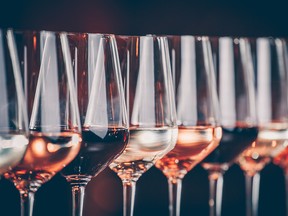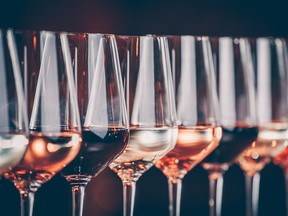Reviews and recommendations are unbiased and products are independently selected. Postmedia may earn an affiliate commission from purchases made through links on this page.
Anthony Gismondi: Vancouver Island producers have lots of wine to sell

The deep freeze that recently beset Okanagan and Similkameen producers did not descend upon Vancouver Island

Article content
I’ll be on Vancouver Island this week for a quick update on the vines as the sap begins to flow; emphasis on the flow part. Contrary to what many think, the deep freeze that recently beset Okanagan and Similkameen producers did not descend upon Vancouver Island in January. Island producers would like you to know that they have plenty of wine to sell you this year and are equally primed for the next couple of vintages, barring any unforeseen wildfires or other weather issues like heat domes.
Advertisement 2
Article content
They won’t be able to fill the suspected gaping hole of missing B.C. wine, even if we don’t know what size it might be yet, but they are hoping to take advantage of a short window at least to tell you their story and get you thinking more about their wines, which seldom leave the island before local consumers and tourists in the know snap them up.
Article content
“We have wine to sell” has become a familiar chant among B.C. wineries, all of whom will be open for business as usual in 2024 and likely won’t miss a beat in 2025, even if they have to import grapes from other parts of the country or nearby Washington and Oregon. Resilience and resolve are another part of the story told by the smallest producers and growers representing the soul of B.C. wine. If any good can come from what looks to be a massive crop failure, it is a stubbornness not to give up but rather to get back to work and grow better grapes down the road.
I have been admiring some online responses about getting on with the job and less about needing handouts. Let’s be clear: They could use some government help, but some will suffer regardless, while others may be forced to leave the business. As cruel as it sounds, fewer players in what has become an overcrowded field might be good for the whole. Most land-based producers are focused on staying positive and remaining committed to making local wines with as small a human footprint as possible.
Advertisement 3
Article content
If that means turning to imported fruit for a year or two to get by, so be it, but with a huge caveat. You’d better be as transparent as a piece of glass when telling consumers what’s in the bottle. There will be no room for the dodgy standards that rule the current offerings marked international blend from imported and domestic wines or vice versa, international blend from domestic and imported wines. Completely different labels would be a good start, and the origin of what is in the bottle should appear on the front label before any nod to the bottle’s B.C. brand.
Climate-related damage aside, I’m more worried about the global business of wine, which I expect will take a beating over the next decade and beyond on several fronts. Obsessive protectionism and taxes continue to block expansion to new markets. The anti-alcohol lobby has more money and influence than the wine industry could ever imagine wielding and is close to winning the big battle, namely, getting the public to buy into their message that no level of alcohol is safe.
Young people are walking away from wine and, perhaps more widely, alcohol for any number of reasons, citing it as too challenging to understand, way too pricey, and, perhaps most problematic, going down the aforementioned rabbit hole that any amount of wine is unhealthy.
Article content
Advertisement 4
Article content
On a more cheerful note, wine has seen all these challenges in one form or another for thousands of years and is still around. Fewer than 50 years ago, wine was a nothing burger in most parts of the world, save for the oldest parts of Europe, so a setback after a half-century of steady growth and runaway prices should be unexpected news.
Since the anti-alcohol movement appears less inclined to quote balanced, scientific, peer-reviewed studies to support its position, I leave you with a personal anecdotal observation. I have met scores of healthy, vibrant, multi-generational wine families, in some cases three and four generations old, all still working and drinking moderately — a votre santé.
Weekend wine picks

Tohu Sauvignon Blanc 2022, Awatere Valley, Marlborough, New Zealand
$26.99 I 90/100
UPC: 9421003130012
Re-tasted about a year later, the 2022 Tohu SB hasn’t changed much. Bright acidity and a screwcap have given youth to this all Marlborough, Awatere Valley white that is awash in citrus blossoms and scents of lemon grass and passion fruit. A bright citrus undercurrent steadies a riper, juicy, pink grapefruit and a saline mineral finish. The Awatere Valley is unique among Marlborough sub-regions, as it is drier and windier than most, which leads to longer growing seasons and riper fruit. It is a fine representative of the Kiwi Sauvignon upper class and the first Maori-owed winery. Oysters anyone?
Advertisement 5
Article content

Wakefield Estate Label Chardonnay 2021, South Australia
$18.99 I 89/100
UPC: 9311659000565
I tasted this 14 months ago, and it is pretty much the same delicious screwcap-sealed Chardonnay today, namely a 70/30 Padthaway/Clare Valley blend. The nose is bright with fresh citrus, lees, and vanilla. The palate is packed with juicy nectarine and bolstered by lightly toasted cashew through the backside. Only a tiny portion of new French oak broadens the palate without quashing the fruit, leaving the finish clean and elegant. At $19, back up the truck. It is in 49 B.C. liquor stores.

Nielson Chardonnay 2022, Santa Barbara County, Central Coast, California
$25-$30 I 90/100
UPC: 732099038687
What I like about this wine is its gradual transition to a brighter, fresher style over the last decade while maintaining its full-flavoured, rich exterior, exhibiting the best of California’s old and new styles. If you are an acid freak, it is not for you, and if you are a butter and a caramel freak, it’s not for you, but if you want both to work together, this a historical wine you may love. The wine opens with fresh citrus, tight-ish tropical fruit, mineral, lees, and strong peach and pear. It is fun to sip but even better with spicy, savoury chicken or sushi. Private wine shops only.
Advertisement 6
Article content

Domaine de Paris Côtes de Provence Rosé 2023, Côtes de Provence, France
$24.99 I 89/100
UPC: 334861001003
A 40/30/20/10 mix of Grenache/Syrah/Cinsault/Carignan is behind this fragrant, delicate, floral, red fruit rosé that is true to the Provençal style. The colour is classic pale pink, with flavours of tart and strawberry fruit and a fresh, elegant finish. Drink now in warm weather and at al fresco lunches. Domaine de Paris has been owned by the Brun family since 1900.

Concha y Toro Marques de Casa Concha Cabernet Sauvignon 2020, Puente Alto, Valle del Maipo, Chile
$27.99 I 90/100
UPC: 07804320333175
The label winemaker Marcelo Papa made famous continues to impress as the vines quietly age. The fruit comes from two Maipo sites near the foothills of the Andes: Puente Alto El Mariscal at 650 metres above sea level and Pirque at 570 metres. Both sites sit on poor alluvial soils loaded with gravel. The result is a delicious, savoury bay leaf note, lightly smoky cassis and cherry fruit aromas, smoky graphite underpinnings, and dense sweet tannins — a classic steak wine. The final blend is 85/8/4/3 Cabernet Sauvignon, Syrah, Petite Verdot and Carmenere aged for 18 months, 63 per cent in French oak barrels — 28 per cent new and 72 per cent second use — and the other 37 per cent in 5,000-litre foudres from Piedmont. Less new oak and larger barrels are the secret to the styling of this wine, which has gone from chocolate, cherries, and vanilla to a more authentic wine of place.
Advertisement 7
Article content
Calendar items
The B.C. Ale Trail has launched its Spring Vancouver Tasting Passport, encouraging beer lovers to support local small businesses while sampling brews from Vancouver’s craft breweries.
You can obtain a Tasting Passport from any of the 31 participating breweries and other businesses until April 30 and claim a stamp for every beer purchased. After earning six unique stamps, drop off the completed ballot at a participating business and enter to win the grand prize, which is a one-night stay for two people at the Hyatt Regency Vancouver and a VIP tasting with brewmaster Iain Hill at Strange Fellows Brewing, multiple gift cards to breweries, two day passes on the Aquabus False Creek Ferry and a B.C. Ale Trail swag pack. More information go to bcaletrail.ca/vancouverpassport.
•••
Jami Seymore of Portland, Ore., CBS affiliate KOIN 6 reports experiments are underway at Oregon State University to protect grapes from being damaged by wildfire smoke or what has become known as the ashtray effect. In what they’re calling their third round of formulation, they’ve successfully blocked more than half of the seven smoke compounds. The spray-on coating has been described as groundbreaking because the FDA has approved it as a food ingredient. Seymore reports that “OSU said there’s still more testing and research to be done, but if successful, they could see this being cleared for use in three to five years.
Advertisement 8
Article content
B.C. wine of the week

Church & State Wines Roussanne 2018-2019, Okanagan Valley
19.99 I 89/100
UPC: 626990363163
I recommend this wine’s 2018 and 2019 vintages since no vintages are listed by B.C. liquor stores. I guess that’s how you fight climate change. I enjoyed both releases, mainly given they sell for $10 less than the original price at the time of their review. Look for an attractive honeysuckle floral, exotic nose. The palate is medium to full weight, with more ripe peach and orange streaked with almonds and pears. The rich and smooth texture, with a lovely lees component, keeps the weight and complexity running through the back of the wine. The 2019 may be a touch thinner and fresher. This is it if you’re looking for something smart and showy to pour alongside lightly spiced and sauced Chinese or Thai dishes.
Value wine of the week

Meyer Chardonnay 2022, Okanagan Valley
$21.83 I 89/100
UPC: 808755007479
The classic Meyer Chardonnay mixes hand-picked fruit from Main Road, Anarchist Mountain, and McLean Creek Road vineyards, and you can still buy this wine online and in private wine shops in what is becoming a tight market for local wine. We love its bright entry, the fresh apple, citrus, and crunchy pear midpalate, with a creamy lees finish flecked with butter and oak. Finesse with length. This is a workhorse Chardonnay for those who require a dependable white that tastes like Chardonnay, tastes like Chardonnay made in B.C., and offers considerable value.
Advertisement 9
Article content
Recommended from Editorial
Bookmark our website and support our journalism: Don’t miss the news you need to know — add VancouverSun.com and TheProvince.com to your bookmarks and sign up for our newsletters here.
You can also support our journalism by becoming a digital subscriber: For just $14 a month, you can get unlimited access to The Vancouver Sun, The Province, National Post and 13 other Canadian news sites. Support us by subscribing today: The Vancouver Sun | The Province.
Article content
Source: vancouversun.com



